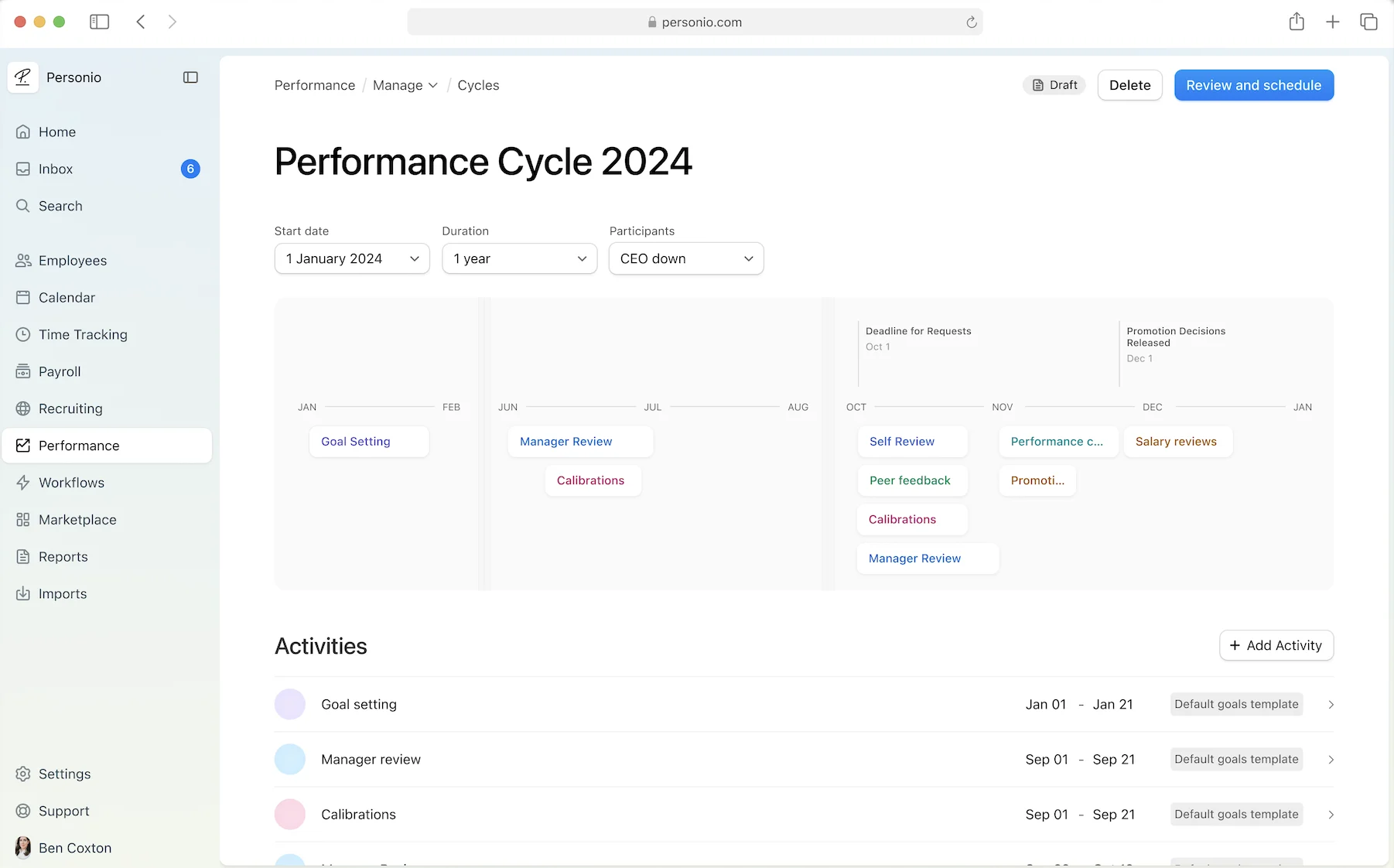
Centralise HR processes in a single platform
Create HR workflows and build better review cycles with Personio's intuitive performance management software
Find out morePerformance Development Reviews (PDRs): Empowering Your Workforce

Traditional annual reviews are falling out of favour in place of performance development reviews (PDRs). With an evolving landscape to monitor, this article will take you through what constitutes a PDR and how you can leverage the process for a more engaged, satisfied and productive workforce. Here's everything you need to know about PDRs.
Employee performance is a critical topic. Discover performance with Personio today.Understanding Performance Development Reviews (PDRs)
What is a performance development review (PDR)?
A performance development review (PDR) is a formal process that occurs regularly, ranging from monthly to annually, to assess and enhance employee performance. PDRs are integral to the performance management cycle, providing a documented snapshot of an employee's progress and setting the stage for future career progression.
The top benefits of PDRs
PDRs offer numerous benefits for both employees and organisations:
For employees: PDRs facilitate career growth by setting clear, achievable goals and providing regular feedback. They help employees understand their strengths, identify areas for improvement and chart a path for long-term success.
For organisations: PDRs drive improved performance and talent development. They align individual objectives with corporate goals, enhance employee engagement and contribute to higher retention rates.
What is the purpose of PDRs?
PDRs are an important part of many organisations’ employee development plans and can form a key part of a strategic HR approach to hiring, motivating, and promoting employees. When HR team members use PDRs as part of their performance management processes this can benefit employees’ careers and evolve your organisation.
How do PDRs differ from appraisals?
Organisations that use the term ‘performance review’, or PDR, tend to be more people-focused than goal-focused. They use PDRs as a helpful, forward-looking tool to help employees and organizations make improvements in the future.
In the UK specifically, HR Grapevine explains that the term ‘performance review’ is more commonly used in the public sector and not-for-profit sector, and the term ‘appraisal’ is more common in other business sectors.
The PDR process: A step-by-step guide
In a typical PDR, managers and employees sit together in a 1:1 setting and go through a list of agreed questions that they have answered separately, in order to compare their answers, address differences, review achievements, and discuss next steps.
Setting expectations and goals
SMART goals: Effective PDRs begin with setting SMART goals—Specific, Measurable, Achievable, Realistic and Time-Bound. These goals provide a clear roadmap for employees, ensuring their efforts are aligned with organisational objectives.
Conducting a performance review
Self-assessment and manager evaluation: Self-assessment is a valuable component of PDRs, encouraging employees to reflect on their achievements and areas for growth. Managers then evaluate these self-assessments, providing a balanced view of performance. HRIS can facilitate this process by offering templates and tracking tools.
Providing constructive feedback
Creating a safe space: Constructive feedback is most effective in a safe, open environment. Managers should foster psychological safety, ensuring employees feel comfortable discussing their challenges and successes.
Delivering Feedback: Feedback should be specific, actionable and balanced, highlighting both strengths and areas for improvement. For example, instead of saying "Improve your communication skills," a manager could say, "In the next quarter, focus on providing clearer updates during team meetings."
Developing an action plan
Clear goals and timelines: An effective PDR concludes with a clear action plan, outlining specific goals and timelines. This plan should identify the resources and support needed to achieve these goals.
Leveraging HRIS: An effective HRIS can help identify resources, track progress and ensure accountability, making it easier to follow through on action plans.
Tracking progress and celebrating achievements
Ongoing communication: Regular check-ins are crucial for tracking progress and maintaining momentum. Celebrating achievements, no matter how small, can boost morale and reinforce positive behaviours.
Leveraging an HRIS for Effective PDRs

An HR software can significantly enhance how your organisation chooses and wants to run PDRs in a scalable fashion. A great HRIS can do this by offering:
Building, scheduling and automating reviews: Ensure PDRs and performance reviews are conducted regularly and on time.
Secure storage of performance metrics and feedback: Maintain a centralised, secure repository for all performance-related information.
Collaborative goal setting and progress tracking: Facilitate joint goal setting and monitor progress in real-time.
Reporting and analytics: Use data-driven insights to make informed decisions and improve performance management strategies.
Best practices: Making the most of PDR conversations
Here are some best practices you should definitely consider when it comes to building, running and hosting PDR conversations between employees and managers.
Create a safe environment: Ensure elements of psychological safety to encourage open and honest communication.
Focus on strengths and areas for improvement: Provide balanced feedback that recognises achievements and identifies growth opportunities.
Use specific examples backed up with data: Support feedback with concrete examples and relevant data.
Encourage employee involvement and participation: Promote self-reflection and active participation in the review process.
Beyond the review: Opportunities for ongoing development
PDRs should be part of a broader culture of continuous learning and development. Managers can foster this culture by:
Providing ongoing feedback and coaching: Regular, informal feedback helps employees stay on track and continuously improve.
Creating an environment of learning: Encourage employees to pursue learning opportunities and support their professional growth.
The role of HR in supporting PDRs

HR can play a critical role in ensuring the success of PDRs by:
Providing training and resources: Equip line managers with the skills and tools needed to conduct effective PDRs.
Developing performance management frameworks: Standardise the PDR process to ensure consistency and fairness.
Facilitating open communication: Promote a culture of transparency and open dialogue between managers and employees.
Run amazing performance programmes with Personio

Performance Development Reviews (PDRs) are essential for fostering employee engagement, development and retention.
By integrating PDRs into your performance management strategy, you can drive individual and organisational success. Personio's all-in-one HR software streamlines processes, offering automated scheduling, secure data storage, collaborative goal setting and powerful analytics.
Embrace PDRs to empower your workforce and achieve your strategic goals. Speak with an expert today to see how Personio can transform how you run performance within your organisation.

